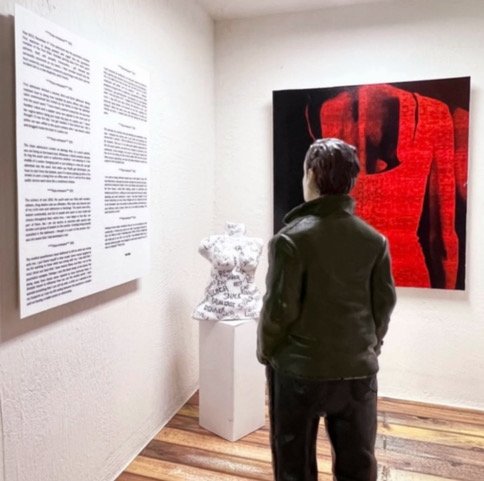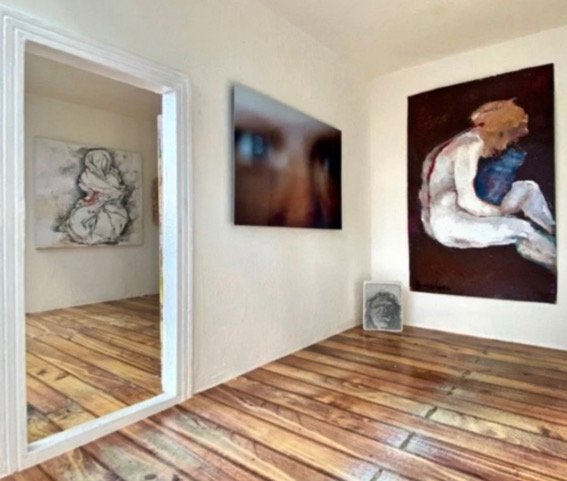Amy Oliver who curates The House of Smalls take the spot light and gives an insight into how she runs a number of micro galleries.
www.thehouseofsmalls.art
instagram.com/thehouseofsmalls
facebook.com/thehouseofsmalls
twitter.com/thehouseOsmalls
1. Gallery owner/curator is not a career path that is ever talked about when we are growing up, what drew you to it as a career choice? Oh I’d love for it to be a career choice but it’s something that until I win the lottery I can only run in my spare time, on a far, far, smaller scale! I’ve always been really interested in the way in which exhibitions are laid out and wondered why many are as they are. I can’t in any way claim to be an expert – I have no training in the arts; indeed, I’ve never completed any further education – but I’ll often spend an equal amount of time looking at a show from a ‘design’ perspective as I do looking at the art itself.
2. What is your opinion on a curator, gallery owner & artist being one person? Or do you think it is important to have these roles ran by separate people? I think that entirely depends on the environment one is within – certainly for a large commercial gallery I’d guess that there should be separate roles each bringing with them the specific knowledge and expertise that the business requires; but for other more intimate galleries, artists’ own galleries, miniature galleries etc, being all those things together gives one control on the final output.
3. How far in advance do you decide on who is showing in your miniature gallery? Around two weeks. When a call closes, I look at the submissions for the first time and then let the selected artists know asap so that they have time to get the work to me. Occasionally, if I feel an artist’s work doesn’t quite fit a particular call or wouldn’t ‘sit’ with other work, but I can see that it would be right for another show, I’ll reserve a future place for that artist or contact them and suggest they submit for another specific exhibition.
4. Do you run open calls to bring in new talent or do you only exhibit artists you know? I run calls for artists across the board. I love having returning artists, and likewise having new artists. It’s really important to me that I run calls for women-only shows – one of the reasons I set up the house was to help give creative women in isolation, or who felt isolated, visibility and a space to connect through commonality, and for that reason I try and do calls with themes that will resonate.
5. How easy/hard was it to set up the gallery, how did you decide on the area, or style your space would become? It was very easy, I bought a dollhouse! It wasn’t my immediate intention to set up an art space for others, but I was feeling very deflated and uninspired and when the gallery idea came to me I thought I’d struck upon a totally new concept! I failed to research as I should have and did not at the time realise how many and how popular small galleries were, particularly through the pandemic, and I still feel an intruder in this regard.
6. As a woman in the art world how much easier or harder have you found it? What were the struggles? And what were the highlights? I find this question difficult to answer – as my own work is generally more about raising awareness than making work to sell, I haven’t been a part of the competitive market as such and therefore haven’t had the struggle with breaking in. Running the dollhouse gallery online only has given me a degree of ‘distance’ - I very much stick within my own online world and I guess, as with anything on social media, wider exposure very much comes down to luck and who one knows. As an aside but with regards to the online presence, I was really pleased when Instagram introduced the ability to turn off the ‘like’ count (personally I think that should be the default setting). Art is so subjective and I felt really uncomfortable with the sometimes significant differences in popularity of artists’ House of Smalls features being on display - particularly given the nature of the shows and the fact that many of the artists are exhibiting for the first time; are feeling vulnerable at having put themselves out there, and/or showing very personal pieces far removed from their usual (public) work. The highlight as both an artist and curator is feedback received from people who’ve found work and shows relatable and helpful in areas generally off the agenda.
7. Do you think the bigger a gallery gets the less in touch they are with ground level art and artists? I’d hope not but I think that unfortunately it’s inevitable in any industry. One thing I’ve always said is that I won’t compromise the integrity of the House shows – if I ever felt that I wasn’t in touch with the art or artists featured in the shows, The House of Smalls would close for the last time and Little Amy and her horse would retire to Italy!
8. What do you look for when searching for new work or artists? I look for work I like visually and/or that carries a message and they’re of course not always the same thing. I think it’s really important for my exhibitions that I select works which first and foremost answer the call themes.
9. Do you think artists should respond to what is happening around them within their work, or change what they do to suit an open call? I think that’s entirely up to them and what they’re hoping to achieve – it’s hard for someone with an established following to change their style even if they want to. Personally, and again with the House calls, I like artists who work from within, who have something to say and who are consistent in their approach in terms of why they create – not necessarily what they create.
10. Who would be the three artists you could curate in a perfect world? That’s really hard! The living biggies would be Dumas and Emin…but they’d have to be in a group show with many others, I couldn’t possibly limit it to three!




